Note: The Climate Institute is dedicated to providing updated facts on climate change issues. Because this information is constantly evolving, the content on this website may not be up-to-date.
The overwhelming majority of peer-reviewed scientific papers, over 99%, support the conclusion that human activity is the primary cause of climate change.
This is largely due to the emissions of heat-trapping greenhouse gasses, which have resulted in a steady increase in global temperatures.
Yearly surface temperature compared to the 20th-century average from 1880–2022. Blue bars indicate cooler-than-average years; red bars show warmer-than-average years. NOAA Climate.gov graph, based on data from the National Centers for Environmental Information.
https://www.ncei.noaa.gov/access/monitoring/climate-at-a-glance/global/time-series

Temperature is a fundamental measurement for describing the climate, and temperature has wide-ranging effects on human life and ecosystems.
Global warming is a result of the greenhouse effect, a process by which the atmosphere traps some of the Sun’s heat, allowing our planet to maintain the necessary conditions for life.
Concentrations of heat-trapping greenhouse gasses are increasing in the Earth’s atmosphere (see the Atmospheric Concentrations of Greenhouse Gases indicator) as a result of human activity. In response, average temperatures at the Earth’s surface are increasing and are expected to continue rising.
The main greenhouse gasses include Carbon dioxide, Methane, Nitrogen oxide, and HCFCs, caused mostly by burning fossil fuels.
The current path of CO2 emissions could increase the global temperature up to 4.4°C by the end of the century.
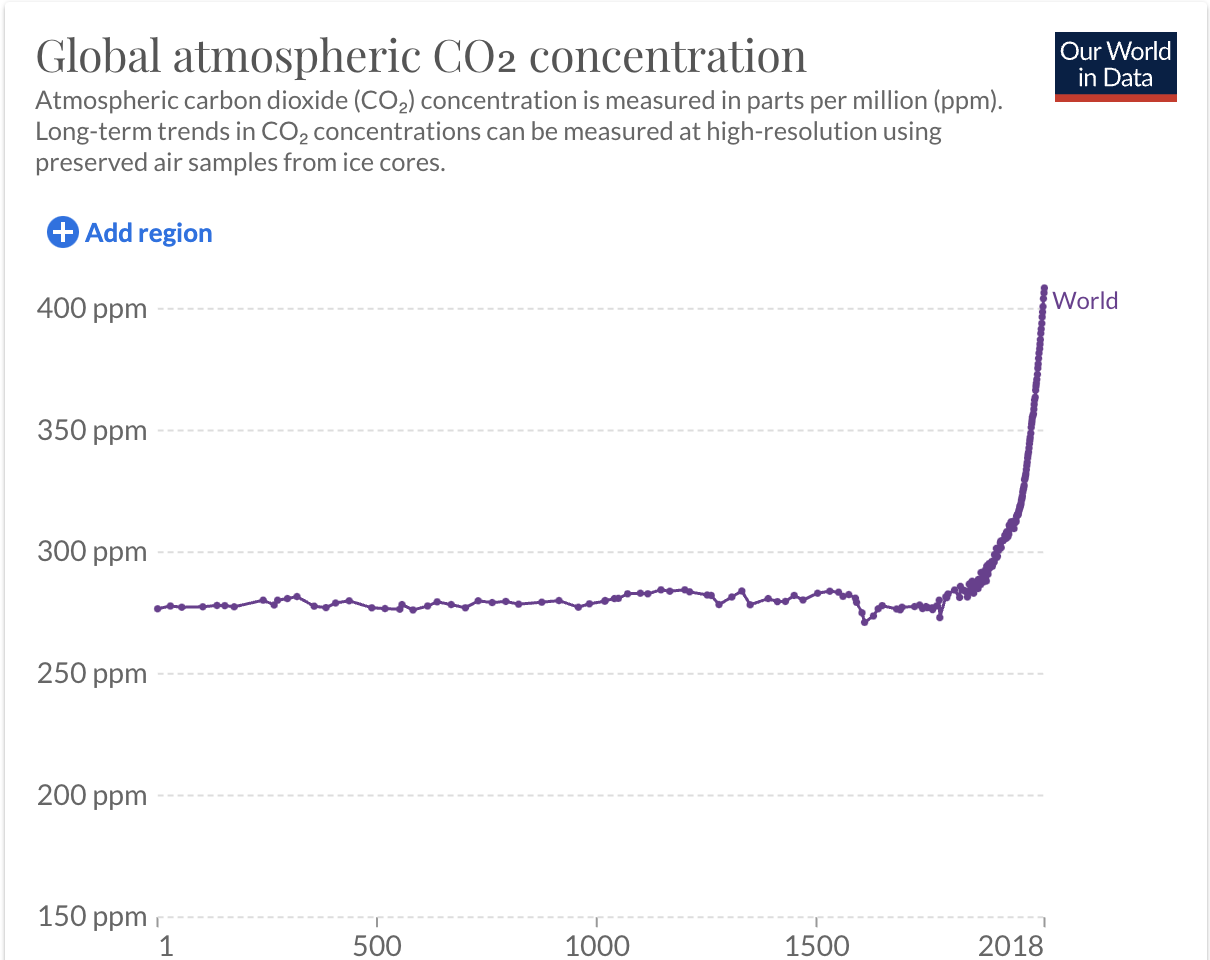
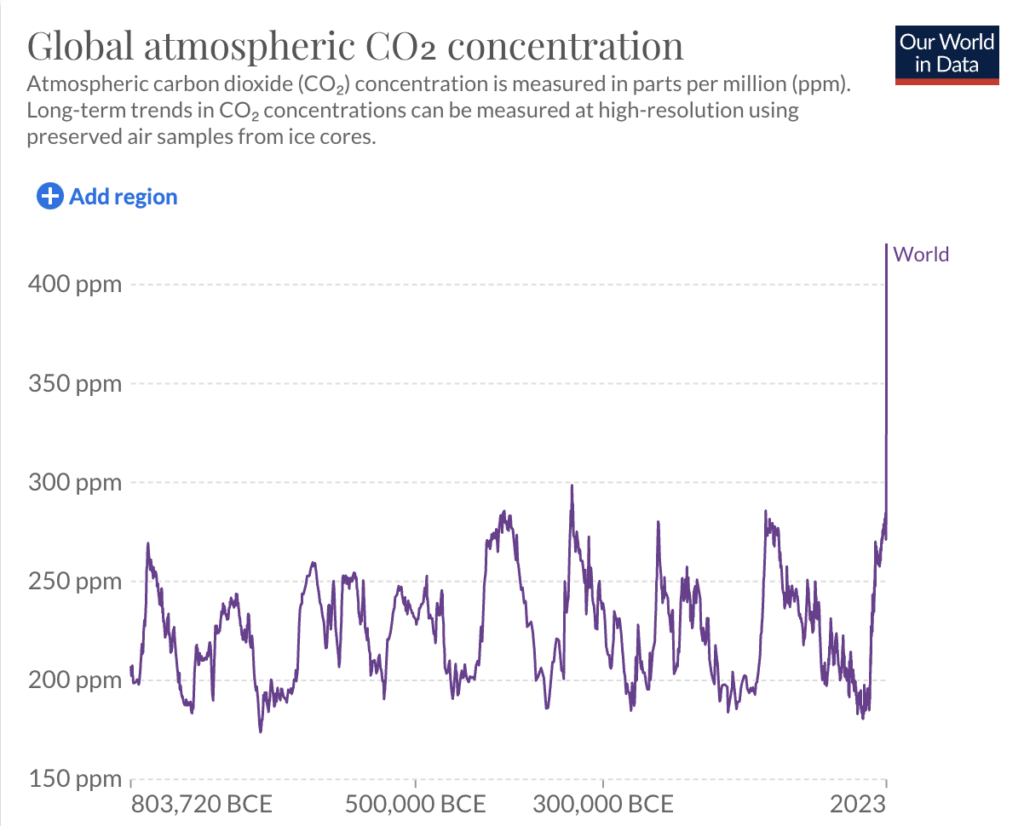
The destruction of land ecosystems and deforestation are some of the leading causes of climate change.
Forests play a crucial role in absorbing carbon dioxide and helping to limit the number of emissions in our atmosphere. However, deforestation can severely hinder nature’s ability to perform this vital function. Trees also serve as carbon storage, and when they are cut down, they release carbon into the atmosphere, contributing to emissions.
Over the last thirty years, the world has lost around 178 million hectares of forest (FAO, 2020). This alarming trend highlights the urgent need to prevent deforestation and promote reforestation efforts to help mitigate the effects of climate change.
The ocean plays a crucial role in regulating the Earth’s climate by absorbing a significant amount of the excess heat trapped in the atmosphere by greenhouse gasses.
Around 90% of the excess heat trapped in the Earth’s system is absorbed by the ocean. Additionally, the ocean takes in approximately 30% of carbon dioxide emissions, which helps to mitigate the effects of greenhouse gasses on the climate (UNFCCC, 2021). Without the ocean’s ability to absorb excess heat and carbon dioxide, the global climate would be significantly more unstable and unpredictable.
The impacts of climate change are vast and pose numerous threats to life on Earth, including humans.
Global warming has led to a range of consequences, such as extreme weather events, the melting of polar ice caps, rising sea levels, the endangerment of ecosystems, and the potential extinction of various species. Additionally, climate change has increased the risk of wildfires, heat waves, hurricanes, floods, and storms, causing displacement, loss of life, and damage to property.
Unfortunately, if action is not taken to address this pressing issue, scientists predict that the situation will only worsen over time.
Extreme Weather Phenomena
Climate change is often linked to large-scale disasters and disruptions attracting media attention.
– Hurricanes
The frequency and intensity of hurricanes have increased since the 1980s, and this trend is projected to continue as the climate continues to warm. In fact, scientists predict that hurricane wind speeds and the proportion of hurricanes that reach the most intense levels will rise by approximately 10% (GFDL, 2023).
– Wildfires
In addition to the increase in hurricanes, wildfire seasons have also lengthened globally.
Nearly all disastrous wildfires are associated with fire-danger conditions driven by climate-related meteorological factors such as a lack of precipitation, high wind speeds, low humidity, and high temperatures (FAO, 2020).
It’s estimated that the area of forest burned has doubled over the past few decades, and by 2050, the land area burned in Western states is expected to increase by two to six times.
– Drought
The likelihood of severe droughts in regions of the United States and the world is amplified by climate change, as rising temperatures intensify evaporation, leading to decreased surface water, soil desertification, and drying vegetation (C2ES, 2023). Droughts can persist through a vicious cycle, where excessively arid soils and reduced vegetation absorb additional solar radiation, causing an increase in temperature that further restrains precipitation, exacerbating droughts in regions already suffering from water scarcity (C2ES, 2023).
Over the past few decades, droughts in the United States have expanded in scope. The prolonged droughts, worsened by heat waves, have resulted in an escalation of wildfires and adversely affected water supply, agricultural practices, transportation, hydroelectric power, and public health (C2ES, 2023).
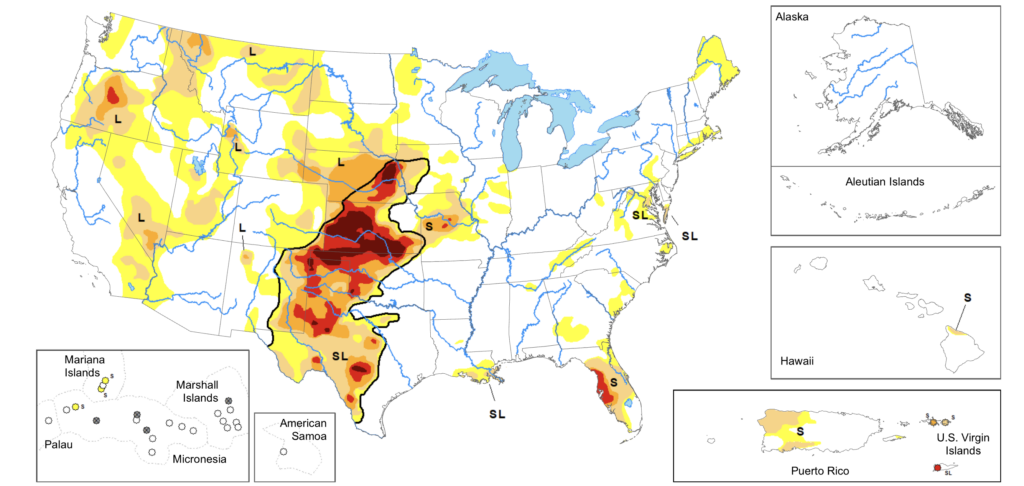

– Flooding
Floods are made more likely by the more extreme weather patterns caused by long-term global climate change (UNEP, 2020).
Higher air and ocean temperatures can increase the potential for evaporation, allowing the atmosphere to retain more moisture content, which can result in intensified precipitation frequency, duration, and/or intensity (UNEP, 2020). Extreme flooding can be instigated by prolonged and heavy precipitation, frequent downpours, or a combination of these factors (UNEP, 2020).
Studies indicate that the North Atlantic area may experience a greater incidence of extreme hydro-meteorological phenomena, including severe winter storms or prolonged summer droughts. Additionally, the occurrence of severe flooding will persist in regions where human settlements have been established on floodplains or low-lying coastal areas (UNEP, 2020).
Low-scale climate events and slow-onset climate-related changes have affected the livelihoods of numerous populations: catastrophic warming, mass extinction of species, the loss of sea ice, melting glaciers and ice sheets, sea level rise, and more intense heat waves. [1]
– Ice Melting and Sea Level Rise
Rising temperatures are causing the polar ice to melt, which in turn is contributing to the rise of sea levels, posing a serious threat to coastal and island communities worldwide.
NASA announced in several reports that Greenland had lost an estimated 280 gigatons of ice annually from 2002 to 2021. This significant loss of ice has resulted in a global sea level rise of approximately 0.03 inches per year.
Similarly, between 2002 and 2020, Antarctica lost an average of 150 gigatons of ice each year, contributing to a global sea level rise of 0.4 millimeters per year.
The Intergovernmental Panel on Climate Change (IPCC) projects that more than one billion people globally could be exposed to coastal-specific climate hazards by 2050, potentially driving these populations to leave their homes (IPCC, 2022).
Antarctic Ice Mass Loss 2002-2020: Ice sheet mass loss on a black background, based on data collected by NASA and JPL/Caltech. https://svs.gsfc.nasa.gov/31158
As a result of climate change, wildlife is facing mounting pressure to adapt quickly to new environmental conditions and human activity. While ecosystems have a certain level of adaptability, many are now approaching or have already exceeded their natural capacity to adapt. This presents a concerning situation, as some ecosystems are struggling to cope with the rapidly changing climate.
It’s estimated that approximately 1 million animal and plant species are currently at risk of extinction, with many facing this fate within a matter of decades. The rate of species loss across the globe is expected to be anywhere from 1,000 to 10,000 times higher than the natural rate of extinction (NOW.TUFTS.edu, 2019). This alarming trend highlights the urgent need to take action to protect and preserve our planet’s biodiversity.
Three-quarters of the land-based environment and about 66% of the marine environment have been significantly altered by human actions (UN.org)
Around 178 million hectares of forest have been lost worldwide over the past three decades (FAO, 2020).
Deforestation and clearing of land for agriculture and grazing cause emissions. Prioritizing nature conservation and embracing net zero strategies against climate change can enhance species’ survival.
Tipping points are being reached and ocean risk is increasing. If the global average temperature increases by 2°C, 99% of the world’s coral reefs will experience heat waves that will damage and destroy them. Whilst in Arctic regions, tipping points may have already been reached such that adaptive practices can no longer work (UNFCCC, 2021).
According to a UN report, almost 33% of reef-forming corals, more than 40% of amphibian species, and more than a third of all marine mammals are threatened with extinction due to climate change.
Every year avoidable environmental factors claim the lives of more than 13 million people around the world (WHO, 2022). Climate change is harming health through air pollution, extreme weather phenomena, poor nutrition, displacement, and more causing more diseases, increasing fatality, and challenging healthcare systems.
– Extreme Heat
Extreme heat is a leading cause of mortality in the United States; without adaptation, deaths could increase more than sixfold.
Estimated increases in heat-related mortality are affected by climate change and population growth, as well as demographic shifts from an aging population. The Atlantic Council Extreme Heat report showed that people aged 65 and older are more than twenty times more likely to die from heat-related events compared to people aged 1 to 44 years.
– Air Pollution
About 99% of the population breathes unhealthy air resulting from the burning of fossil fuels.
Air pollution is responsible for taking the lives of 7 million people each year (WHO, 2022).
– Water Pollution
Poor management of wastewater from urban, industrial, and agricultural activities leads to the contamination and chemical pollution of drinking water for millions of people.
This puts their health in danger. According to a WHO report, each year, an estimated 829,000 people die due to diarrhea caused by unsafe drinking water, poor sanitation, and lack of hand hygiene.
– Displacement and Climate Refugees
About 3.3 to 3.6 billion people’s daily lives are highly vulnerable to climate change. Without action, climate change will push up to 130 million people into poverty in the next decade (World Bank, 2021). The World Bank’s Groundswell report could cause over 200 million people to migrate within their own countries by 2050 (Groundswell, 2021).
According to the latest IDMC GRID report, from the total of 38 million internal displacements registered in 2021, 23.7 million were triggered by disasters.
Countries such as South Sudan, Ethiopia, the Philippines, Afghanistan, and China are among the most severely affected by climate change (IDMC, 2022). These nations face challenges such as droughts, floods, sea-level rise, and extreme weather events that threaten the lives and livelihoods of their citizens, ultimately leading to displacement and migration (IDMC, 2022).
Climate migration refers to the relocation of individuals or communities who are compelled to leave their homes due to the impact of climate change on their environment. This may include sudden or gradual changes such as rising sea levels, extreme weather events, and droughts. These changes may force people to move within their own country or across international borders, either on a temporary or permanent basis. Climate migration is a specific type of environmental migration that is driven primarily by the effects of climate change. This phenomenon has become increasingly prevalent in recent years as the impacts of climate change continue to worsen and disrupt the lives of individuals and communities around the world (IOM, 2019).
– Climate Justice
The climate crisis is an issue of profound injustice: the poorest populations in the world contribute the least to climate change.
In fact, data shows that 74 of the world’s most impoverished countries account for less than 10% of global greenhouse gas emissions (World Bank, 2021). This means that the communities that are most vulnerable to the impacts of climate change, such as droughts, floods, and food insecurity, are the ones who have contributed the least to the problem.
Most refugees come from countries more vulnerable to climate change and less ready to adapt to its impacts. South Sudan, Ethiopia, the Philippines, Afghanistan, and China are among the most affected countries (IDMC, 2022).
https://www.migrationdataportal.org/infographic/annual-weather-related-internal-displacements-millions-2012-2021-average
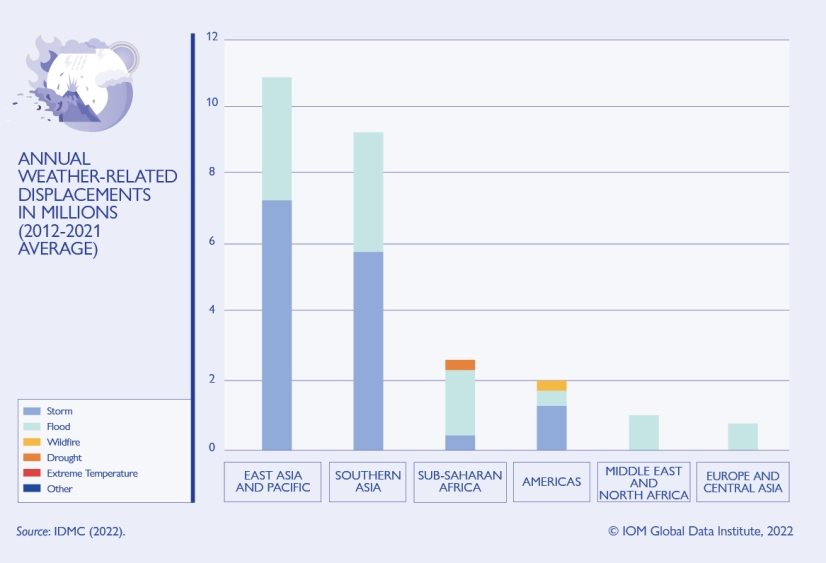
Climate change is a major driver of the global hunger crisis. It has a severe impact on crops due to the combined effects of rising temperatures and extreme weather conditions.
Experts predict that every 1°C increase in global temperature will lead to a 6% decrease in global wheat yields and a 10% decrease in rice yields, which could have devastating consequences on undernutrition and stunting in impoverished regions (Atlantic Council, 2021).
Wheat may experience yield losses of up to 11 percent by 2050 (Atlantic Council, 2021).
The vulnerability of key crops, such as corn, soy, and wheat, to extreme heat puts countries at risk of significant economic consequences. As the largest global corn exporter, with nearly a third of total exports, the United States faces the potential for significant international repercussions (Atlantic Council, 2021).
The severity of the effects caused by climate change will depend on human action. We must promote the adoption of climate-resilient, sustainable and low-carbon lifestyles.
Research shows that we can avoid the worst climate impacts by cutting emissions. As indicated in the Paris Agreement, in order to avert the most devastating effects of climate change and keep global warming to no more than 1.5°C, emissions must drop by 45% by 2030 and 100% by 2050 (UN.org)
To achieve net zero, greenhouse gas emissions must be reduced to as close to zero as possible. Any remaining emissions must be absorbed from the atmosphere by oceans and forests.
The energy sector is the source of around three-quarters of global greenhouse gas emissions, compared to 20 percent in 2011 (UN.org). Replacing polluting coal, gas, and oil-fired power with energy from renewable sources, such as wind or solar, would dramatically reduce carbon emissions.
Green energy is derived from natural resources like sunlight, wind, and water, which are abundant and continuously replenished.
Dr. Jane Lubchenko, Expert Group Co-Chair of the High-Level Panel for a sustainable ocean economy, reported that promoting ocean-based renewable energy has the potential to provide around 20% reduction in emissions needed by 2050 in order to keep global temperatures to 1.5 degrees Celsius (UNFCCC, 2021).
Climate-resilient development refers to the practice of designing and implementing development projects, policies, and strategies that consider the potential impacts of climate change and aim to minimize the negative effects and enhance the ability of communities and ecosystems to adapt to changing climate conditions (IPCC Sixth Assessment Report).
Climate resilient development involves integrating climate change considerations into all aspects of development planning, with a keen eye for local and country-specific needs and making inclusive development choices that prioritize a systemic approach to risk reduction, equity, and justice (IPCC Sixth Assessment Report).
Atlantic Council. “Extreme Heat: The Economic and Social Consequences for the United States.” atlanticcouncil.org. Atlantic Council, August 2021. https://www.atlanticcouncil.org/wp-content/uploads/2021/08/Extreme-Heat-Report-2021.pdf
Clement, Viviane, Kanta Kumari Rigaud, Alex de Sherbinin, Bryan Jones, Susana Adamo, Jacob Schewe, Nian Sadiq, Elham Shabahat. “Groundswell Part 2: Acting on Internal Climate Migration.” openknowledge.worldbank.org. World Bank, 13 September 2021. https://openknowledge.worldbank.org/
C2ES. “Drought and Climate Change.” c2es.org. Center for Climate and Energy Solutions, 2023. https://www.c2es.org/content/drought-and-climate-change/#:~:text=How%20climate%20change%20contributes%20to,would%20be%20in%20cooler%20conditions.
EPA. “Climate Change Indicators: Atmospheric Concentrations of Greenhouse Gases.” epa.gov. United States Environmental Protection Agency, 2022. https://www.epa.gov/climate-indicators/climate-change-indicators-atmospheric-concentrations-greenhouse-gases.
FAO. “Global Forest Resources Assessment 2020: Main Report.” fao.org. Food and Agriculture Organization of the United Nations, 2020. https://doi.org/10.4060/ca9825en.
Ferguson, Laura. “The Extinction Crisis.” now.tufts.edu. Tufts Now, 21 May 2019.https://now.tufts.edu/2019/05/21/extinction-crisis#:~:text=We%27re%20now%20losing%20species,species%20going%20extinct%20by%202050.
IDMC. “Global Report on Internal Displacement 2022.” internal-displacement.org. Internal Displacement Monitoring Center, 2022. https://www.internal-displacement.org/global-report/grid2022/
IOM. “Glossary on Migration.” environmentalmigration.iom.int. UN International Organization for Migration, 2019. https://environmentalmigration.iom.int/sites/g/files/tmzbdl1411/files/iml_34_glossary.pdf
IPBES. “UN Report: Nature’s Dangerous Decline ‘Unprecedented’; Species Extinction Rates ‘Accelerating’.” un.org. United Nations, 06 May 2019. https://www.un.org/sustainabledevelopment/blog/2019/05/nature-decline-unprecedented-report/
IPCC. “IPCC Sixth Assessment Report. Climate Change 2022: Impacts, Adaptation, and Vulnerability.” ipcc.ch. Intergovernmental Panel on Climate Change, 2022. https://www.ipcc.ch/report/ar6/wg2/
Knutson, Tom. “Global Warming and Hurricanes.” gfdl.noaa.gov. NOAA/GFDL, Feb 2023. https://www.gfdl.noaa.gov/global-warming-and-hurricanes/
Lynas, Mark, Benjamin Z Houlton, and Simon Perry. “Greater than 99% consensus on human-caused climate change in the peer-reviewed scientific literature.” Environmental Research Letters 16, no. 11 (Oct 2021): 1-7. DOI 10.1088/1748-9326/ac2966
NASA, and JPL/Caltech. “Antarctic Ice Mass Loss 2002-2020.” svs.gsfc.nasa.gov. NASA and JPL/Caltech, 21 March 2021. https://svs.gsfc.nasa.gov/31158
Nishio, Akihiko. “When poverty meets climate change: A critical challenge that demands cross-cutting solutions.” blogs.worldbank.org. World Bank Blogs, 5 November 2021. https://blogs.worldbank.org/climatechange/when-poverty-meets-climate-change-critical-challenge-demands-cross-cutting-solutions
NOAA, and NCEI. “Global Time Series: Climate at a Glance.” ncei.noaa.gov. National Centers for Environmental Information, March 2023. https://www.ncei.noaa.gov/access/monitoring/climate-at-a-glance/global/time-series.
UNFCCC. “Urgent Climate Action Is Needed to Safeguard the World’s Oceans.” unfcc.int. UN Climate Change, 30 April 2021. https://unfccc.int/news/urgent-climate-action-is-needed-to-safeguard-the-world-s-oceans
UNEP. “How climate change is making record-breaking floods the new normal.” unep.org. United Nations, 2020. https://www.unep.org/news-and-stories/story/how-climate-change-making-record-breaking-floods-new-normal
WHO. “Billions of people still breathe unhealthy air: new WHO data.” who.int. World Health Organization, 4 April 2022. https://www.who.int/news/item/04-04-2022-billions-of-people-still-breathe-unhealthy-air-new-who-data
WHO. “Drinking-water” who.int. World Health Organization, 21 March 2022. https://www.who.int/news-room/fact-sheets/detail/drinking-water#:~:text=Contaminated%20water%20and%20poor%20sanitation,individuals%20to%20preventable%20health%20risks
CELT Mission:
To empower those most affected by climate change to become problem solvers and develop solutions to climate and environmental challenges.
CELT projects are focused on developing solutions for climate and environmental challenges faced by current and future generations – and by doing so we hope to link environmental problem solvers with organizations and individuals from around the world.
CELT has an array of problem solving tools, enabling online users to design and implement win-win solutions to energy and climate challenges.
CELT OBJECTIVES:

John C. Topping, Jr
The impact of CELT on hundreds of students and community members is thanks to the hard work and dedication of John C. Topping, Jr. He was a Member of Dartmouth Class of 1964, Co-Founder and President of the Climate Institute from 1986 to 2021, winner in 2002 of Dartmouth’s first Dr. Martin Luther King, Jr. Social Justice Award for Lifetime Achievement and recipient in 2008 from the Intergovernmental Panel on Climate Change of a Certificate of Recognition “for Contributing to the Award of the Nobel Peace Prize for 2007 to the IPCC”

Justin Mankin – Director of the Center for Environmental Leadership Training
Justin Mankin is an assistant professor in the Department of Geography at Dartmouth College and PI of Dartmouth’s Climate Modeling & Impacts Group. He also holds courtesy appointments in the Department of Earth Sciences (EARS) and the Ecology Evolution Environment & Society (EEES) graduate program and is an Adjunct Associate Research Scientist in the Division of Ocean & Climate Physics at Lamont-Doherty Earth Observatory of Columbia University. His previous career was as an intelligence officer working in South Asia and the Middle East. He holds degrees from Columbia (B.A., M.P.A.) the London School of Economics (M.Sc.) and Stanford (Ph.D.). His research centers on understanding and constraining uncertainty in the human impacts of climate change.

Katie Glance
President of the Center for Environmental Leadership Training Climate Institute Board Member and Recipient of the John Topping Jr. Climate Initiative Award
Robert Bartles of Meriden, NH, Member of Dartmouth Class of 1964, Trustee of Kimball Union Academy, member of Board of Advisors of Climate Institute, and successful entrepreneur in publications wholesaling
Loren McGean of Meriden, NH, Member of Dartmouth Class of 1992, poet and writer who also served as coach of Dartmouth figure skating team when it won five consecutive national collegiate championships
John C. Topping, Jr. of Hanover, NH, Member of Dartmouth Class of 1964, Co-Founder and President of the Climate Institute since 1986, winner in 2002 of Dartmouth’s first Dr. Martin Luther King, Jr. Social Justice Award for Lifetime Achievement and recipient in 2008 from the Intergovernmental Panel on Climate Change of a Certificate of Recognition “for Contributing to the Award of the Nobel Peace Prize for 2007 to the IPCC”
For more information contact: Katie Glance
katie.m.glance.23@dartmouth.
The Climate Institute has a long partnership with the National Oceanic and Atmospheric Agency (NOAA) using Science on a Sphere technology as the foundation for Climate Theaters around the world. The long collaboration has resulted in expansion of climate education efforts with a focus on using data, technology, photography and interactive exhibits to tell the story of climate change.

Climate Theaters use data sets and satellite imagery from the National Aeronautical and Space Administration (NASA), the Global Atmospheric Watch Network and NOAA’s Greenhouse Gas Network. The display technology includes high-speed computers, projectors and advanced imaging techniques to create the illusion of Earth, Sun, moon or any celestial body rotating in space. Weather and other geophysical data can be shown moving across the surface of the earth and other planets.
The sphere is a six feet in diameter animated globe. Infrared data from five geostationary satellites is combined and set into motion over the surface of the earth. Animated atmospheric storms, climate change impacts, and ocean temperature can be shown on the sphere, which explains sometimes complex environmental processes in a way that is simultaneously intuitive and captivating.
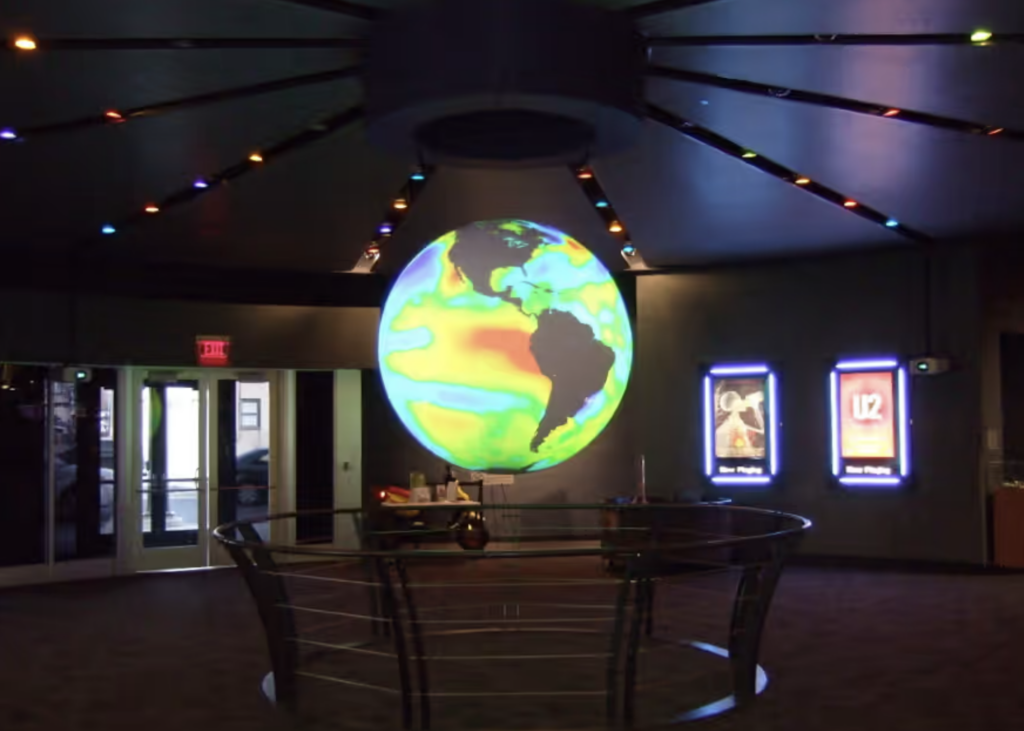
Dynamic Climate Education
Climate theaters are located within museums, educational parks, aquariums and other science centers. Visitors can participate in the interactive network via computer kiosks that access information on climate impacts and response options.
Over 300 sphere-casts are available on various Earth Science topics. The Climate Institute also has the capability to develop new content.
If you are interested in creating a Climate Theater experience, reach out to info@climate.org.
Students attend a moderated discussion about climate change inside the “Climate Planet” on the sidelines of last week’s U.N. climate conference in Bonn, Germany. (Katie Worth/FRONTLINE)
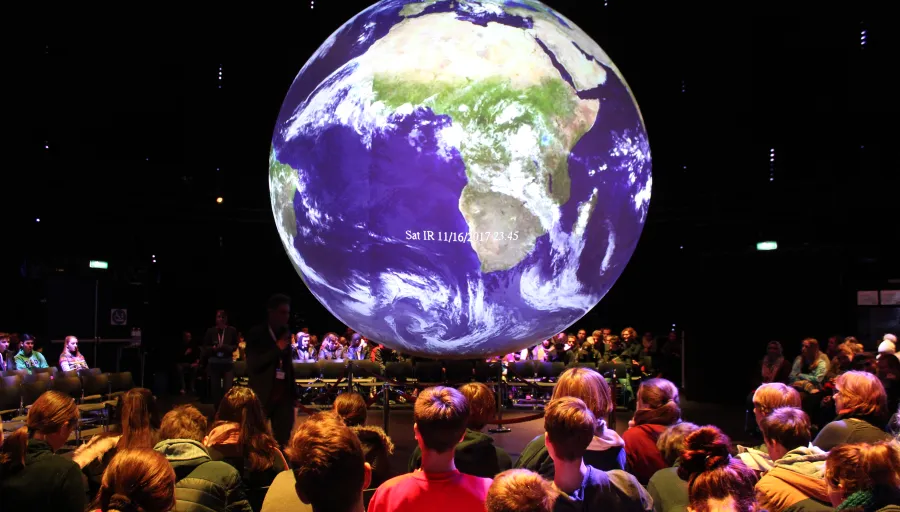


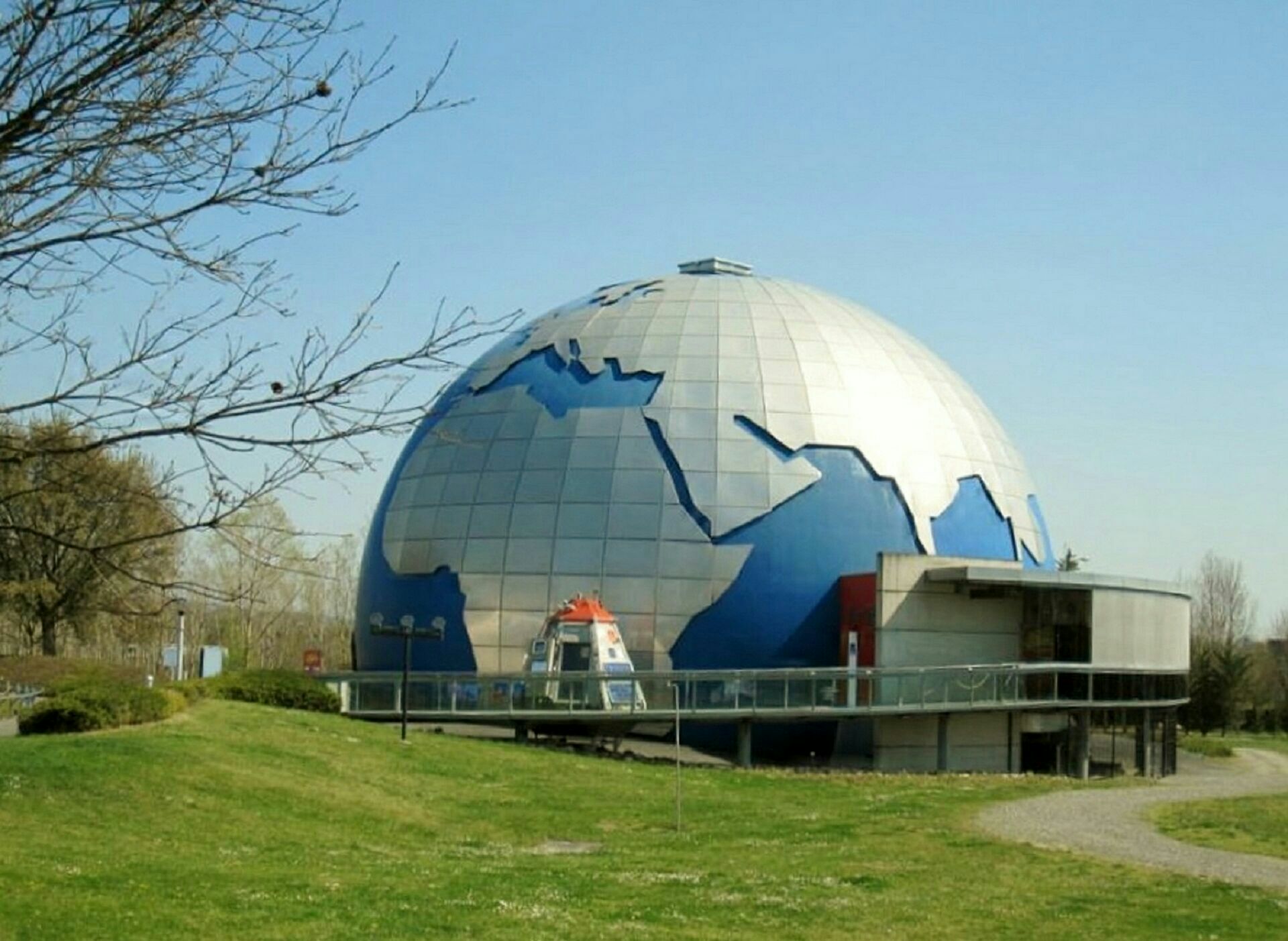
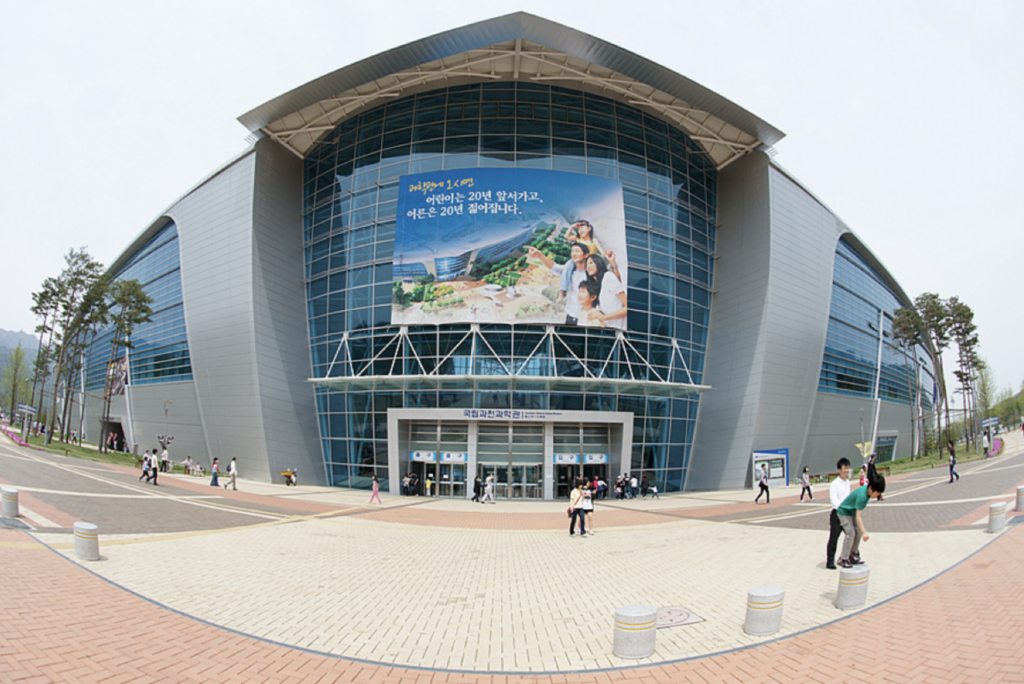



The Climate Institute is interested in data visualization and developing the next generation of technology tools to tell the stories of climate change. We are working with partners to build awareness and understanding of climate change issues by exploring tools such as 3 and 4-D technology, “immersion” experiences, virtual reality (VR), climate games and other tools to educate a diverse range of audiences. We’d love to hear from you if you’d like to partner on technology development. We’re excited about the future of technology to enhance climate education around the world.


Climate Games are a great way to learn about climate change, from tools for the very young to more advanced climate modeling systems. Here are a few to explore:
The National Aeronautics and Space Administration
NASA’s Climate Kids website is a resource featuring articles, videos, images and games focused on the science of climate change. The site includes educational activities and games to teach kids of all ages about Earth’s systems, water cycle, weather and climate.
The National Oceanic and Atmospheric Administration
Climate Change Policy Simulator
C-ROADS is an online policy simulator that allows users to test and visualize the long-term impacts of climate strategies across distinct regional groups. The C-ROADS Simulator has helped the world to understand the impact of the emission reduction pledges countries have proposed to the United Nations. C-ROADS is made available for free to make insights about what it takes to address climate change more accessible.
Address:
200 Massachusetts Ave. NW
Suite 700
Washington, DC 20001
Phone:
202-552-0163
Email:
info@climate.org
REPORTS
Publications
Climate Alert Archive
NEWS & EVENTS
Breaking News
Upcoming Events
Climate Blog
TOPPING INTERNS
About John Topping Jr.
Apply for an Internship or Fellowship
© Copyright 2023 Climate Institute | All Rights Reserved | Site by Blink